Crocodiles are ambush hunters, waiting for fish or land animals to come close, then rushing out to attack. As cold-blooded predators, they have a very slow metabolism, and thus can survive long periods without food. Despite their appearance of being slow, crocodiles are top predators in their environment, and various species have been observed attacking and killing sharks.
Herodotus claimed that Nile crocodiles have a symbiotic relationship with certain birds like the Egyptian plover, which enter the crocodile's mouth and pick leeches that have been feeding on the crocodile's blood, but there is no evidence of this interaction actually occurring in any crocodile species, and it is most likely mythical or allegorical fiction.
Many large crocodilians swallow stones (called gastroliths or stomach stones) which may act as ballast to balance their body or assist in crushing food, similar to grit in birds.
Salt glands are present in the tongues of most crocodylids and they have a pore opening on the surface of the tongue. They appear to be similar to those in marine turtles; they seem to be absent in Alligatoridae.
Crocodilians can produce sounds during distress and in aggressive displays. They can also hear well and the tympanic membranes are concealed by flat flaps that may be raised or lowered by muscles.
Crocodiles eat fish, birds, mammals and occasionally smaller crocodiles.
Crocodiles are protected in many parts of the world, but they also are farmed commercially. Their hide is tanned and used to make leather goods such as shoes and handbags, whilst crocodile meat is also considered a delicacy. The most commonly farmed species are the Saltwater and Nile crocodiles, while a hybrid of the Saltwater and the rare Siamese Crocodile is also bred in Asian farms. Farming has resulted in an increase in the Saltwater crocodile population in Australia, as eggs are usually harvested from the wild, so landowners have an incentive to conserve crocodile habitat.
Crocodiles are more closely related to birds and dinosaurs than to most animals classified as reptiles, the three being included in the group Archosauria ('ruling reptiles'). See Crocodilia for more information.
Crocodile embryos do not have sex chromosomes, and unlike humans sex is not determined genetically. Sex is determined by temperature, with males produced at around 31.6 °C (89 °F), and females produced at slightly lower and higher temperatures. The average incubation period is around 80 days, and also is dependent upon temperature.
Crocodiles may possess a form of homing instinct. Three rogue saltwater crocodiles were relocated 400 kilometres by helicopter in northern Australia but had returned to their original locations within three weeks, based on data obtained from tracking devices attached to the reptiles.

The land speed record for a crocodile is 17 km/h (11 mph) measured in a galloping Australian freshwater crocodile. Maximum speed varies from species to species. Certain types of crocodiles can indeed gallop, including Cuban crocodiles, New Guinea crocodiles, African dwarf crocodiles, and even small Nile crocodiles. The fastest means by which most species can move is a kind of "belly run", where the body moves in a snake-like fashion, limbs splayed out to either side paddling away frantically while the tail whips to and fro. Crocodiles can reach speeds of 10 or 11 km/h (around 7 mph) when they "belly run", and often faster if they're slipping down muddy riverbanks. Another form of locomotion is the "high walk" where the body is raised clear off the ground.
Crocodiles do not have sweat glands and release heat through their mouths. They often sleep with their mouths open and may even pant like a dog.
It is reported that when the Nile crocodile has lurked a long time underwater to catch prey, and thus has built up a big oxygen debt, when it has caught and eaten that prey, it closes its right aortic arch and uses its left aortic arch to flush blood loaded with carbon dioxide from its muscles directly to its stomach; the resulting excess acidity in its blood supply makes it much easier for the stomach lining to secrete more stomach acid to quickly dissolve bulks of swallowed prey flesh and bone.
[ READ MORE ]
 Some species of sea lion are readily trainable and are often a popular attraction at zoos and aquariums. The archetypal circus "seal" performing behaviors such as throwing and catching balls on its nose and clapping is almost always a sea lion.
Some species of sea lion are readily trainable and are often a popular attraction at zoos and aquariums. The archetypal circus "seal" performing behaviors such as throwing and catching balls on its nose and clapping is almost always a sea lion. Sea lion attacks on humans are rare. In a highly unusual attack in 2007 in Western Australia a sea lion leapt from the water and seriously mauled a 13-year old girl surfing behind a speedboat. The sea lion appeared to be preparing for a second attack when the girl was rescued. An Australian marine biologist opined the sea lion may have viewed the girl "like a rag doll toy" to be played with. In San Francisco where an increasingly large population of California sea lion crowds dock along San Francisco Bay, there have been incidents in recent years of swimmers being bitten on the leg by large aggressive males, possibly as a territorial act.
Sea lion attacks on humans are rare. In a highly unusual attack in 2007 in Western Australia a sea lion leapt from the water and seriously mauled a 13-year old girl surfing behind a speedboat. The sea lion appeared to be preparing for a second attack when the girl was rescued. An Australian marine biologist opined the sea lion may have viewed the girl "like a rag doll toy" to be played with. In San Francisco where an increasingly large population of California sea lion crowds dock along San Francisco Bay, there have been incidents in recent years of swimmers being bitten on the leg by large aggressive males, possibly as a territorial act.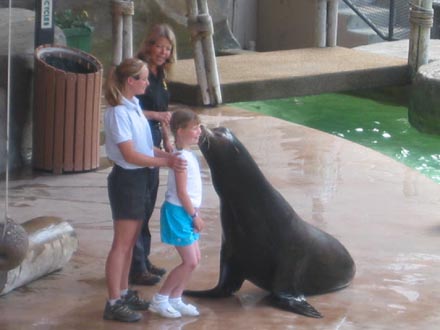 Sea lions have also been reported to assist or save humans who show signs of distress in the open waters. In June of 2000, Kevin Hines leaped into the San Francisco bay and it was reported that he was saved by a sea lion that kept him afloat and breathing till the paramedics arrived.
Sea lions have also been reported to assist or save humans who show signs of distress in the open waters. In June of 2000, Kevin Hines leaped into the San Francisco bay and it was reported that he was saved by a sea lion that kept him afloat and breathing till the paramedics arrived.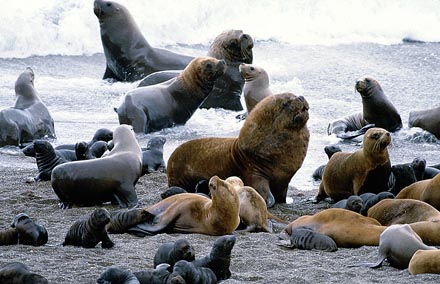 Mating occurs between August and December, and the pups are born between December and February. Males arrive first and defend territories, but switch to female defense as they were joined by them. Males defend females from neighbours and intruders with threat displays and by fighting, and forcefully hold pre-estrous females near them. On rocky beaches, males defend small territories where females aggregate and herd them. On more open cobble or sandy beaches, males stay along the surf line and try to herd females going to sea to cool down or forage. The number of actual fights between males depends on the number of females in heat. The first males to arrive have the longest tenures and achieve the most copulations. Males are usually able to keep around three females in their harem, but some have as many as 18.
Mating occurs between August and December, and the pups are born between December and February. Males arrive first and defend territories, but switch to female defense as they were joined by them. Males defend females from neighbours and intruders with threat displays and by fighting, and forcefully hold pre-estrous females near them. On rocky beaches, males defend small territories where females aggregate and herd them. On more open cobble or sandy beaches, males stay along the surf line and try to herd females going to sea to cool down or forage. The number of actual fights between males depends on the number of females in heat. The first males to arrive have the longest tenures and achieve the most copulations. Males are usually able to keep around three females in their harem, but some have as many as 18. During the breeding season, males that fail to secure territories and females (mostly subadults) will cause group raids in an attempt to change the status-quo and gain access to the females. These raids cause chaos in the breeding harems, often splitting mothers from their young. The resident males are unable to fight off all the raiders and keep all the females in their territorial boundaries. Nevertheless, raiders are often unsuccessful securing a female. Sometimes an invading male will abduct pups, possibly as an attempt to control the females. They may also take pups as substitutes for mature females. Pups are often severely injured or killed when this happens. Group raids are more common on sandy beaches than rocky ones.
During the breeding season, males that fail to secure territories and females (mostly subadults) will cause group raids in an attempt to change the status-quo and gain access to the females. These raids cause chaos in the breeding harems, often splitting mothers from their young. The resident males are unable to fight off all the raiders and keep all the females in their territorial boundaries. Nevertheless, raiders are often unsuccessful securing a female. Sometimes an invading male will abduct pups, possibly as an attempt to control the females. They may also take pups as substitutes for mature females. Pups are often severely injured or killed when this happens. Group raids are more common on sandy beaches than rocky ones. Sea lion mothers remain with their newborn pups for nearly a week, and then start a routine of taking trips back into the sea for food and coming back to nurse the pups. They will act aggressively to other females who come close to their pups, as well as alien pups who try to get milk from them. Pups first enter the water at about four weeks and are weaned at about 12 months. This is normally when the mother gives birth to a new pup. Pups gradually spent more time in the nearshore surf and develop swimming skills.
Sea lion mothers remain with their newborn pups for nearly a week, and then start a routine of taking trips back into the sea for food and coming back to nurse the pups. They will act aggressively to other females who come close to their pups, as well as alien pups who try to get milk from them. Pups first enter the water at about four weeks and are weaned at about 12 months. This is normally when the mother gives birth to a new pup. Pups gradually spent more time in the nearshore surf and develop swimming skills.
 The South American sea lion (Otaria flavescens, formerly Otaria byronia), also called the southern sea lion and the Patagonian sea lion, is a sea lion found on the Chilean, Peruvian, Uruguayan, Argentine and Southern Brazilian coasts. It is the only member of the genus Otaria. Its scientific name was subject to controversy, with some taxonomists referring to it as Otaria flavescens and others referring to it as Otaria byronia. The former eventually won out. Locally, it is known by several names though the most common ones are lobo marino (sea wolf) and león marino (sea lion).
The South American sea lion (Otaria flavescens, formerly Otaria byronia), also called the southern sea lion and the Patagonian sea lion, is a sea lion found on the Chilean, Peruvian, Uruguayan, Argentine and Southern Brazilian coasts. It is the only member of the genus Otaria. Its scientific name was subject to controversy, with some taxonomists referring to it as Otaria flavescens and others referring to it as Otaria byronia. The former eventually won out. Locally, it is known by several names though the most common ones are lobo marino (sea wolf) and león marino (sea lion). The South American sea lion is perhaps the archetypal sea lion in appearance. Males have a very large head with a well-developed mane, making them the most lionesque of the eared seals. They are twice the weight of females. Both males and females are orange or brown coloured with upturned snouts. The manes on males are lighter than females, and female fur on the head and neck is lighter than that of males. Pups are born greyish orange ventrally and black dorsally and moult into a more chocolate colour.
The South American sea lion is perhaps the archetypal sea lion in appearance. Males have a very large head with a well-developed mane, making them the most lionesque of the eared seals. They are twice the weight of females. Both males and females are orange or brown coloured with upturned snouts. The manes on males are lighter than females, and female fur on the head and neck is lighter than that of males. Pups are born greyish orange ventrally and black dorsally and moult into a more chocolate colour. As its name suggests, the South American sea lion is found along the coast and offshore islands of South America. It ranges from Peru south to Chile in the Pacific and then north to southern Brazil in the Atlantic. It generally breeds in the southern part of its range and travels north in winter and spring. Notable breeding colonies include Lobos Island, Uruguay; Peninsula Valdes, Argentina; Beagle Channel and the Falkland Islands. Some individuals wander as far north as southern Ecuador, although apparently they never bred there.
As its name suggests, the South American sea lion is found along the coast and offshore islands of South America. It ranges from Peru south to Chile in the Pacific and then north to southern Brazil in the Atlantic. It generally breeds in the southern part of its range and travels north in winter and spring. Notable breeding colonies include Lobos Island, Uruguay; Peninsula Valdes, Argentina; Beagle Channel and the Falkland Islands. Some individuals wander as far north as southern Ecuador, although apparently they never bred there. Size greatly varies between species, from the dwarf crocodile to the saltwater crocodile. Species of Palaeosuchus and Osteolaemus grow to an adult size of just 1 metre (3.3 ft) to 1.5 metres (4.9 ft). Larger species can reach over 4.85 metres (15.9 ft) long and weigh well over 1,200 kilograms (2,600 lb). Crocodilians show pronounced sexual dimorphism with males growing much larger and more rapidly than females. Despite their large adult size, crocodiles start their life at around 20 centimetres (7.9 in) long. The largest species of crocodile is the saltwater crocodile, found in eastern India, northern Australia, throughout south-east Asia, and in the surrounding waters.
Size greatly varies between species, from the dwarf crocodile to the saltwater crocodile. Species of Palaeosuchus and Osteolaemus grow to an adult size of just 1 metre (3.3 ft) to 1.5 metres (4.9 ft). Larger species can reach over 4.85 metres (15.9 ft) long and weigh well over 1,200 kilograms (2,600 lb). Crocodilians show pronounced sexual dimorphism with males growing much larger and more rapidly than females. Despite their large adult size, crocodiles start their life at around 20 centimetres (7.9 in) long. The largest species of crocodile is the saltwater crocodile, found in eastern India, northern Australia, throughout south-east Asia, and in the surrounding waters. Two larger certifiable records are both of 6.2 metres (20 ft) crocodiles. The first crocodile was shot in the Mary River in the Northern Territory of Australia in 1974 by poachers and measured by wildlife rangers. The second crocodile was killed in 1983 in the Fly River, Papua New Guinea. In the case of the second crocodile it was actually the skin that was measured by zoologist Jerome Montague, and as skins are known to underestimate the size of the actual animal, it is possible this crocodile was at least another 10 cm longer.
Two larger certifiable records are both of 6.2 metres (20 ft) crocodiles. The first crocodile was shot in the Mary River in the Northern Territory of Australia in 1974 by poachers and measured by wildlife rangers. The second crocodile was killed in 1983 in the Fly River, Papua New Guinea. In the case of the second crocodile it was actually the skin that was measured by zoologist Jerome Montague, and as skins are known to underestimate the size of the actual animal, it is possible this crocodile was at least another 10 cm longer. The largest captive crocodile alive in the US is located in South Carolina. In June 2002, Alligator Adventure introduced Utan, born in 1964 in Thailand. At 20 feet (6.1 m) long and weighing in at more than a ton, "Utan", the largest crocodile to ever be exhibited in the United States, made his new home in Myrtle Beach.
The largest captive crocodile alive in the US is located in South Carolina. In June 2002, Alligator Adventure introduced Utan, born in 1964 in Thailand. At 20 feet (6.1 m) long and weighing in at more than a ton, "Utan", the largest crocodile to ever be exhibited in the United States, made his new home in Myrtle Beach.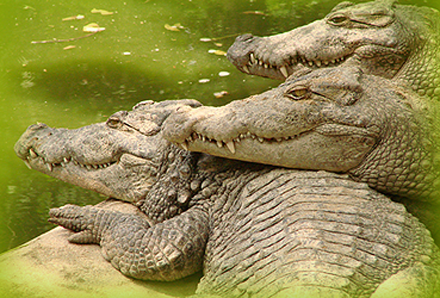 There is no reliable way of measuring crocodile age, although several techniques are used to derive a reasonable guess. The most common method is to measure lamellar growth rings in bones and teeth—each ring corresponds to a change in growth rate which typically occurs once a year between dry and wet seasons. Bearing these inaccuracies in mind, the oldest crocodilians appear to be the largest species. C. porosus is estimated to live around 70 years on average, and there is limited evidence that some individuals may exceed 100 years. One of the oldest crocodiles recorded died in a zoo in Russia. A male freshwater crocodile at the Australia Zoo is estimated to be 130 years old. He was rescued from the wild by Bob Irwin and Steve Irwin after being shot twice by hunters. As a result of the shootings, this crocodile (known affectionately as "Mr. Freshy") has lost his right eye.
There is no reliable way of measuring crocodile age, although several techniques are used to derive a reasonable guess. The most common method is to measure lamellar growth rings in bones and teeth—each ring corresponds to a change in growth rate which typically occurs once a year between dry and wet seasons. Bearing these inaccuracies in mind, the oldest crocodilians appear to be the largest species. C. porosus is estimated to live around 70 years on average, and there is limited evidence that some individuals may exceed 100 years. One of the oldest crocodiles recorded died in a zoo in Russia. A male freshwater crocodile at the Australia Zoo is estimated to be 130 years old. He was rescued from the wild by Bob Irwin and Steve Irwin after being shot twice by hunters. As a result of the shootings, this crocodile (known affectionately as "Mr. Freshy") has lost his right eye. Crocodiles have smooth skin on their belly and side, while their dorsal surface is armoured with large osteoderms. The armoured skin has scales and is thick and rugged, providing some protection. They are still able to absorb heat through this thick, rugged armour as a network of small capillaries push blood through the scales to absorb heat.
Crocodiles have smooth skin on their belly and side, while their dorsal surface is armoured with large osteoderms. The armoured skin has scales and is thick and rugged, providing some protection. They are still able to absorb heat through this thick, rugged armour as a network of small capillaries push blood through the scales to absorb heat.
















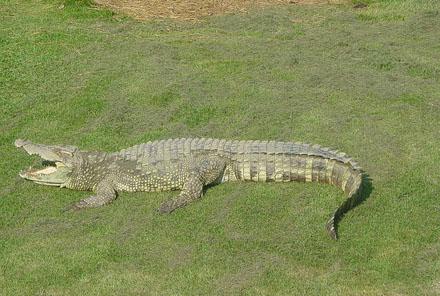
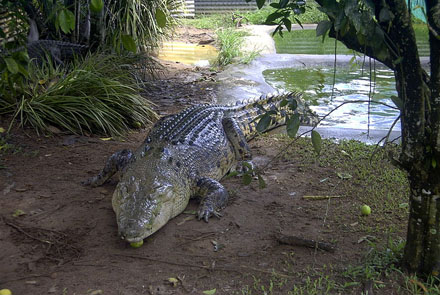











 East Siberian brown bear
East Siberian brown bear
 Eurasian Brown Bear
Eurasian Brown Bear Grizzly Bear
Grizzly Bear Himalayan Brown Bear
Himalayan Brown Bear Kamchatka Brown Bear
Kamchatka Brown Bear Kodiak Bear
Kodiak Bear Syrian Brown Bear
Syrian Brown Bear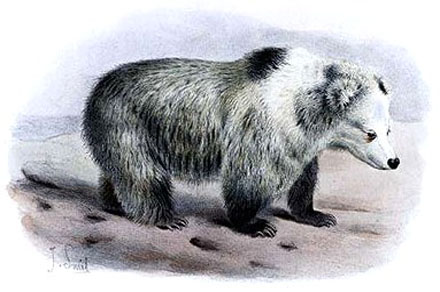 Tibetan Blue Bear
Tibetan Blue Bear Ussuri Brown Bear
Ussuri Brown Bear